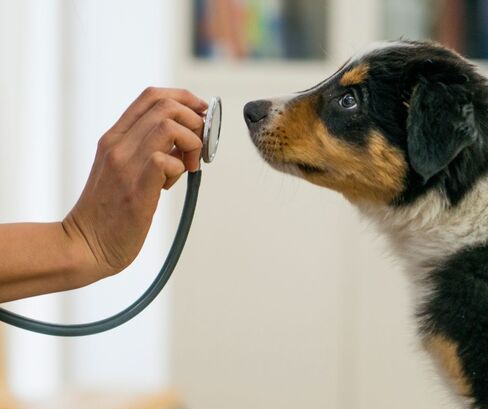|
Neutering and spaying are standard procedures veterinarians perform to prevent dogs from reproducing and address various health and behavioural issues. Early neutering, also known as paediatric neutering, involves performing these procedures at a young age, typically before the dog reaches sexual maturity. While the optimal time for early neutering varies depending on the breed and individual circumstances, it generally occurs between 8 weeks and 6 months of age. Early neutering in dogs has several advantages. One significant benefit is that it reduces the risk of certain types of cancer, such as testicular, ovarian, and uterine cancer. Additionally, early neutering can prevent unwanted behaviours such as marking, humping, and aggression, which can be common in unneutered dogs. Moreover, neutering can help prevent certain health issues, such as prostate problems and pyometra (a severe infection of the uterus). However, early neutering can also have some disadvantages. One potential disadvantage is that it can lead to certain orthopaedic issues, such as hip dysplasia, particularly in larger breeds. Additionally, neutering can cause a dog's metabolism to slow down, which can lead to weight gain and other health issues. There is also some evidence that early neutering can lead to an increased risk of certain types of cancer, such as osteosarcoma and hemangiosarcoma. When deciding whether to neuter or spay a dog, it is essential to consider the differences between males and females. For example, neutering a male dog can prevent testicular cancer and reduce the risk of prostate problems, while spaying a female dog can prevent ovarian and uterine cancer. Additionally, it is important to consider the optimal timing for these procedures, which can vary depending on the breed and individual circumstances. Ultimately, the decision to neuter or spay a dog should be made in consultation with a veterinarian who can provide personalized advice based on the dog's health, behaviour, and breed. Advantages of Early Neutering/Spaying Population Control Dog overpopulation is a major issue in many parts of the world. To control the problem, neutering or spaying dogs is considered an effective solution. One of the primary reasons for neutering or spaying dogs is to prevent the overpopulation of unwanted animals. By spaying or neutering dogs, accidental litters can be avoided, which in turn reduces the number of homeless or euthanized dogs. Both male and female dogs can contribute to the overpopulation problem, but female dogs can produce more offspring, making early spaying particularly effective in controlling the dog population. Early spaying of female dogs before their first heat cycle is recommended as it can significantly reduce the risk of certain health problems, such as mammary tumours and uterine infections. Moreover, early spaying can also prevent unwanted behaviours such as aggression and roaming. Behavioural Benefits When it comes to pets, neutering and spaying are common procedures recommended by many veterinarians. Neutering refers to the surgical removal of a male pet's testicles, while spaying involves the removal of a female pet's ovaries and uterus. Both procedures are done under general anesthesia and are considered safe. Neutering can help reduce certain undesirable behaviours in male pets, such as roaming, aggression, and urine marking. Roaming behaviour is often seen in unneutered males who are trying to find a mate. This behaviour can lead to pets getting lost, hurt or even killed. Aggression is another behaviour that can be reduced with neutering. It is especially important to neuter aggressive male pets as their behaviour can be a threat to their owners and other pets. Lastly, urine marking is common in unneutered males and can be a nuisance for pet owners. Spaying, on the other hand, can prevent behaviours associated with a female pet's heat cycle. During this time, female pets can become more vocal and restless and may attract male pets. These behaviours can lead to unwanted litters, while the attraction to male pets can put your pet at risk of getting lost or hurt. Health Benefits It is highly recommended to spay or neuter your pet at an early age as it offers several health benefits to your furry friend. Early spaying or neutering can significantly reduce the risk of reproductive-related health complications later in life. Both male and female pets stand to gain from these reduced risks, but female pets may experience more immediate health benefits due to the prevention of pregnancy-related complications. For female pets, spaying at an early age can prevent health issues such as mammary tumours and uterine infections (pyometra), which can be life-threatening if left untreated. Spaying also eliminates the risk of unwanted litter and the associated stress and health risks that come with pregnancy and giving birth. For male pets, neutering at an early age can help prevent testicular cancer and prostate problems. It can also help reduce aggressive behaviour, marking, and roaming tendencies, making them easier to manage and less prone to fighting with other animals. Cost Savings Early neutering or spaying of pets can have several benefits that go beyond just preventing unwanted litters. You can save money on veterinary care and breeding-related expenses by spaying or neutering your pet early. Firstly, early intervention can prevent unwanted litter and the costs associated with caring for and finding homes for the offspring. Spaying or neutering your pet can also help prevent certain health issues, such as cancer and infections, which can be costly to treat. It is worth noting that the cost savings associated with early neutering or spaying apply to both male and female pets equally. The procedures are typically less complicated and require fewer resources when performed at a younger age. This means the recovery time is shorter, and your pet can return to normal activities more quickly. Convenience and Timing One of pet owners' most important decisions is whether to neuter or spay their pets. Early neutering or spaying can help pet owners deal with reproductive concerns before they become problematic. This process involves the surgical removal of the pet's reproductive organs, rendering them incapable of reproducing. This eliminates the need to manage intact dogs during heat cycles or the risk of accidental mating. Female pets experience heat cycles, which can be inconvenient and increase the risk of unwanted pregnancy. During this time, female pets can attract male pets, and the owner needs to monitor and separate them to avoid accidental mating. Early spaying can eliminate the need to monitor and separate females during their heat cycles. Timing is more critical for females, and they should be spayed before their first heat cycle to ensure maximum health benefits. Male pets, on the other hand, do not experience heat cycles. However, neutering them can help reduce the risk of prostate cancer and other health issues. It can also help reduce aggressive behaviour, territorial marking, and wandering. It is recommended to neuter male pets at around six months of age, but it can be done at any age. Disadvantages of Early Neutering/Spaying Impact on Growth and Development Evidence suggests that early neutering or spaying of dogs, which involves removing their reproductive organs at a young age, may impact their growth and development. Specifically, early neutering can cause alterations in skeletal and physical maturity, which can lead to various health problems in the long term. Studies have found that there may be a correlation between early neutering and an increased risk of certain orthopedic issues, such as hip dysplasia and cruciate ligament injuries. These conditions can be painful and debilitating for dogs and may require expensive and invasive treatments to manage. It is worth noting that both male and female dogs can experience growth-related concerns as a result of early neutering, but the impact may vary depending on the breed and their individual characteristics. For example, larger breeds of dogs may be more susceptible to growth abnormalities associated with early neutering and may be at a higher risk of developing orthopedic issues as a result. Hormonal Imbalance Neutering or spaying your pet is a common procedure that removes the source of sex hormones, such as testosterone and estrogen. While this procedure is beneficial for controlling the pet population and reducing behaviour problems, it may also lead to hormonal imbalances and potential health issues. For instance, removing the source of sex hormones can cause changes in metabolism, leading to an increased risk of obesity. Obesity in pets can lead to various health problems such as heart disease, diabetes, and joint issues. Neutering or spaying may increase some pets' risk of urinary incontinence. Research suggests that female pets may be more prone to incontinence after spaying due to a weakened bladder sphincter. This condition can cause involuntary leakage of urine, which can be challenging to manage and may be socially embarrassing for pets and their owners alike. Additionally, neutering or spaying may increase some pets' risk of certain cancers. Although the procedure can reduce the risk of some cancers, such as ovarian or testicular cancer, it may increase the risk of other types of cancers, such as bone or prostate cancer. Therefore, it is essential to consult with your veterinarian about the potential health risks and benefits of neutering or spaying your pet and weigh the options carefully before making a decision. Behavioural Changes Neutering or spaying is a common procedure performed on pets to address various issues, including undesirable behaviours. However, although the surgery has its benefits, it can also lead to changes in personality and temperament. After the procedure, pets may exhibit decreased activity levels, increased fearfulness, and altered social interactions. Some pets may become more aloof, while others may become clingier than before. It is important to note that both male and female pets can experience behavioural changes after neutering or spaying. However, the type and amount of changes may vary. For example, some male pets may become less aggressive after neutering, while female pets may exhibit fewer maternal behaviours. Delayed Maturation of Secondary Sexual Characteristics When a dog is neutered or spayed at an early age, their secondary sexual characteristics, such as coat texture and behaviour, may develop later. This delayed maturation can significantly impact the dog's appearance and temperament, causing it to deviate from breed standards and owner expectations. In male dogs, testosterone plays a vital role in the development of certain characteristics such as muscle mass, coat density, and behaviour. Therefore, neutering or spaying early can delay the maturation of these traits, resulting in a more pronounced effect on males than on females. The delay in maturation may cause a male dog to exhibit a less masculine appearance and behaviour. For instance, the dog may have a less muscular physique, a thinner coat, and a less aggressive temperament. On the other hand, females may also experience changes in their coat texture and behaviour but to a lesser extent. Increased Risk of Certain Health Conditions Research indicates that there may be some disadvantages to neutering or spaying pets at an early age. Specifically, studies have suggested that there is a potential link between early neutering or spaying and an increased risk of certain health conditions. These conditions include certain types of cancer (such as osteosarcoma and hemangiosarcoma), hypothyroidism, and immune-mediated diseases. It is important to note that while this link has been observed, it does not necessarily mean that early neutering or spaying directly causes these conditions. In addition, the specific health risks associated with early neutering or spaying may vary depending on the pet's gender. Both male and female pets may face an elevated risk of certain health conditions following early neutering or spaying, but the prevalence and nature of these risks may differ. For example, female pets may have an increased risk of certain cancers associated with hormone imbalances, such as mammary tumours. On the other hand, male pets may be more susceptible to immune-mediated diseases such as diabetes, allergies, and inflammatory bowel disease. Pet owners must be aware of these potential health risks and discuss the best course of action with their veterinarian. While neutering or spaying can provide a number of benefits, including reducing the risk of certain reproductive health issues and unwanted litter, it is important to carefully weigh the potential risks and benefits before making a decision. Optimal Timing for Neutering/Spaying
Determining the optimal timing for neutering/spaying requires considering various factors, including breed, size, health status, and individual circumstances. While there is no one-size-fits-all approach, here are some general guidelines: Small Breeds Early neutering/spaying (around 6 months of age) is often recommended for small breed dogs to minimise the risk of unwanted pregnancies and reproductive-related health issues. Large Breeds Delaying neutering/spaying until skeletal maturity (around 12-18 months) may be advisable for large breed dogs to allow for proper growth and development and reduce the risk of orthopaedic problems. Mixed Breeds The optimal timing may vary for mixed-breed dogs depending on their size, breed composition, and individual characteristics. Consultation with a veterinarian can help determine the most appropriate timing. Health Considerations Dogs with certain health conditions or genetic predispositions may require special considerations regarding the timing of neutering/spaying. Veterinarians may recommend delaying the procedure until the dog's health status is stable or addressing concurrent medical issues before proceeding. Behavioural Issues Neutering/spaying may be recommended earlier for dogs with significant behavioural issues related to the intact status, such as aggression or roaming. However, behavioural assessment and training should also be considered as part of a comprehensive approach to behaviour modification. In conclusion, early neutering/spaying in canines offers several advantages, including population control, behavioural benefits, and health advantages. However, it also presents certain disadvantages, such as potential impacts on growth and development, hormonal imbalance, behavioural changes, delayed maturation of secondary sexual characteristics, and increased risk of certain health conditions. While the decision to neuter or spay a dog at an early age involves weighing these advantages and disadvantages, it's essential to consider the individual needs of each dog, including their breed, size, health status, and behavioural characteristics. For many dogs, early neutering/spaying can provide significant benefits, including preventing unwanted litters, reducing the risk of reproductive-related health issues, and addressing behavioural concerns. However, potential drawbacks such as impacts on growth, hormonal changes, and behavioural alterations should be carefully considered, especially for large breed dogs or those with specific health concerns. Ultimately, the optimal timing for neutering/spaying should be based on a comprehensive veterinarian assessment, considering the dog's unique circumstances and the latest research findings. By weighing the pros and cons and making informed decisions, pet owners can ensure their canine companions' well-being and long-term health while also contributing to responsible pet population management. Given these findings, it is important for dog owners to carefully consider the potential risks and benefits of early neutering before making a decision. Consulting with a veterinarian can help to provide more information and guidance on this topic. If you want to learn more tricks and tips and be involved in a community of like-minded individuals, join our Facebook group at: |
AuthorJoanna Whitehead Archives
June 2024
Categories
All
|




 RSS Feed
RSS Feed
